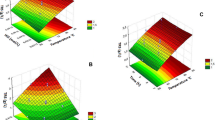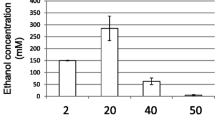Abstract
Green macroalgae have gained attention as promising renewable sources for biorefining. Despite the wide potential availability of green macroalgae, their utilization has been limited to ethanol production, hindering their further application. In this study, we report that a bacterium, Halomonas sp. strain BL6 (isolated from a mangrove forest in Bach Long, Nam Dinh Province, Vietnam), produces pyruvate from a saccharified solution of the green seaweed Ulva reticulata and secretes it into the medium. Pyruvate, an important α-oxocarboxylic acid, plays a central role in energy and carbon metabolism in living organisms and is used mainly for the synthesis of various chemicals and polymers or as an ingredient or additive in food, cosmetics, and pharmaceuticals. To investigate the possibility of using U. reticulata from the seashore of Vietnam as biomass feedstock, the chemical composition and saccharification yield of this seaweed were studied. Dry biomass of U. reticulata was found to contain 65.5% carbohydrate, 10.3% protein, 1.8% lipid, and 10.6% ash. Reducing sugar content reached 608.79 mg g−1 of biomass after pretreatment with diluted acid and 24 h of incubation with 50 IU g−1 Viscozyme L. The resulting sugars were fermented by Halomonas sp. strain BL6 to produce pyruvate, and the maximal pyruvate concentration reached 55.23 g L−1 after 72 h of cultivation. This study is the first to report the production of valuable compounds other than bioethanol products, such as pyruvate, from U. reticulata hydrolysate by a Halomonas strain.







Similar content being viewed by others
References
Alves A, Sousa RA, Reis RL (2013) A practical perspective on ulvan extracted from green algae. J Appl Phycol 25:407–424
Arahal DR, Vreeland RH, Litchfield CD, Mormile MR, Tindall BJ, Oren A, Bejar V, Quesada E, Ventosa A (2007) Recommended minimal standards for describing new taxa of the family Halomonadaceae. Int J Syst Evol Microbiol 57:2436–2446
Berntsson S (1955) Spectrophotometric determination of pyruvic acid by salicylaldehyde method. Anal Chem 27:1659–1660
Borowitzka M (1992) Algal biotechnology products and processes—matching science and economics. J Appl Phycol 4:267–279
Bruno Z, Srdan G, Vuorilehto K, Durda V-R, Ralf T (2004) Process strategies to enhance pyruvate production with recombinant Escherichia coli: from repetitive fed-batch to in situ product recovery with fully integrated electrodialysis. Biotechnol Bioeng 85:638–646
Choi JI, Kim HJ, Kim JH, Byun MW, Soo Chun B, Hyun Ahn D, Hwang YJ, Kim DJ, Kim GH, Lee JW (2009) Application of gamma irradiation for the enhanced physiological properties of polysaccharides from seaweeds. Appl Radiat Isot 67:1277–1281
Deshavath NN, Mohan M, Veeranki VD, Goud VV, Pinnamaneni SR, Benarjee T (2017) Dilute acid pretreatment of sorghum biomass to maximize the hemicellulose hydrolysis with minimized levels of fermentative inhibitors for bioethanol production. 3 Biotech 7:139
Dhasayan A, Kiran GS, Selvin J (2014) Production and characterisation of glycolipid biosurfactant by Halomonas sp. MB-30 for potential application in enhanced oil recovery. Appl Biochem Biotechnol 174:2571–2584
El Harchi M, Fakihi Kachkach EZ, El Mtili N (2018) Optimization of thermal acid hydrolysis for bioethanol production from Ulva rigida with yeast Pachysolen tannophilus. S Afr J Bot 115:161–169
Fakihi Kachkach FZ, El Harchi M, El Mtili N (2014) In vitro effect of Ulva rigida extract on the growth of Lepidium sativum and Allium cepa. Moroccan J Biol 11:26–31
Feng D, Liu H, Li F, Peng J, Song Q (2011) Optimization of dilute acid hydrolysis of Enteromorpha. Chin J Oceanol Limnol 29:1243–1248
Hamouda RA, Sherif SA, Dawoud GTM, Ghareeb MM (2016) Enhancement of bioethanol production from Ulva fasciata by biological and chemical saccharification. Rendiconti Lincei 27:665–672
Hernández-Garibay E, Zertuche-González JA, Pacheco-Ruiz I (2011) Isolation and chemicals characterization of algal polysaccharides from the green seaweed Ulva clathrata (Roth) C. Agardh. J Appl Phycol 129:491–498
Hong DD, Hien HM (2004) Nutritional analysis of Vietnamese seaweeds (macroalgae) for food and medicine. BioFactor 22:323–325
Hong DD, Hien HM, Son PN (2007) Use of Vietnamese seaweed for functional food, medicine and biofertilizer. J Appl Phycol 19:817–826
Hong DD, Hien HM, Anh HTL (2011) Studies on the analgesic and anti-inflammatory activities of Sargassum swartzii (Turner) C. Agardh (Phaeophyta) and Ulva reticulata Forsskal (Chlorophyta) in experiment animal models. Afr J Biotechnol 10:2308–2314
Jang SS, Shirai Y, Uchida M, Wakisaka M (2012) Production of mono sugar from acid hydrolysis of seaweed. Afr J Biotechnol 11:1953–1963
Jeong GT, Ra CH, Hong YK, Kim JK, Kong IS, Kim SK, Park DH (2015) Conversion of red algae Gracilaria verrucosa to sugars, levulinic acid and 5 hydroxymethylfurfural. Bioprocess Biosyst Eng 38:207–217
Jiang R, Ingle KN, Golberg A (2016) Macroalgae (seaweed) for liquid transportation biofuel production: what is next? Algal Res 14:48–57
Jiao GL, Yu GL, Wang W, Zhao XL, Zhang JZ, Stephen HE (2012) Properties of polysaccharides in several seaweed from Atlantic Canada and their potential anti-influenza viral activities. J Ocean Univ China 11:205–212
Karray R, Hamza M, Sayadi S (2015) Evaluation of ultrasonic, acid, thermor-alkaline and enzymatic pre-treatment on anaerobic digestion of Ulva rigida for biogas production. Bioresour Technol 187:205–213
Kawai S, Ohashi K, Yoshida S, Fujii M, Mikami S, Sato N, Murata K (2014) Bacterial pyruvate production from alginate, a promising carbon source from marine brown macroalgae. J Biosci Bioeng 117:269–274
Kawata Y, Aiba S (2010) Poly(3-hydroxybutyrate) production by isolated Halomonas sp. KM-1 using waste glycerol. Biosci Biotechnol Biochem 74:175–177
Kawata Y, Kawasaki K, Shigeri Y (2012) Efficient secreted production of (R)-3-hydroxybutyric acid from living Halomonas sp. KM-1 under successive aerobic and microaerobic conditions. Appl Microbiol Biotechnol 96:913–920
Kawata Y, Jin YX, Nojiri M (2013) Efficient secretion of (R)-3-hydroxybutyric acid from Halomonas sp. KM-1 cultured with saccharified Japanese cedar under microaerobic conditions. Bioresour Technol 140:443–445
Kawata Y, Nishimura T, Matsushita T, Tsubota J (2016) Efficient production and secretion of pyruvate from Halomonas sp. KM-1 under aerobic conditions. AMB Express 6:22
Kim NJ, Li H, Jung K, Chang HN, Lee PC (2011) Ethanol production from marine algal hydrolysates using Escherichia coli KO11. Bioresour Technol 102:7466–7469
Kumar M, Trivedi N, Reddy CR, Jha B (2011) Toxic effects of imidazolium ionic liquids on the green seaweed Ulva lactuca: oxidative stress and DNA damage. Chem Res Toxicol 24:1882–1890
Lee SY, Chang JH, Lee SB (2014) Chemical composition, saccharification yield, and the potential of green seaweed Ulva pertusa. Biotechnol Bioprocess Eng 19:1022–1033
Li Y, Chen J, Lun SY (2001) Biotechnological production of pyruvic acid. Appl Microbiol Biotechnol 57:451–459
Mata JA, Martınez-Cánovas J, Quesada E, Bèjar V (2002) A detailed phenotypic characterisation of the type strains of Halomonas species. Syst Appl Microbiol 25:360–375
Meinita MDN, Kang JY, Jeong GT, Koo HM, Park SM, Hong YK (2012) Bioethanol production from the acid hydrolysate of the carrageenophyte Kappaphycus alvarezii (cottonii). J Appl Phycol 24:857–862
Miller GL (1959) Use of dinitrosalicylic acid for determination of reducing sugar. Anal Chem 31:426–428
Nguyen MT, Seung PC, Jinwon L, Jae HL, Sang JS (2009) Hydrothermal acid pretreatment of Chlamydomonas reinhardtii biomass for ethanol production. J Microbiol Biotechnol 19:161–166
Nguyen VT, Le NH, Lin SM, Steen F, De Clerk O (2013) Checklist of the marine macroalgae of Vietnam. Bot Mar 56:207–227
Offei F, Mensah M, Thygesen A, Kemausuor F (2018) Seaweed bioethanol production: a process selection review on hydrolysis and fermentation. Fermentation 4:99
Pádua M, Fontoura PSG, Mathias AL (2004) Chemical composition of Ulvaria oxysperma (Kützing) Bliding, Ulva lactuca (Linnaeus) and Ulva fascita (Delile). Braz Arch Biol Technol 47:49–55
Pal D, Keshav A, Mazumdar B, Kumar A, Uslu H (2017) Production and recovery of pyruvic acid: recent advances. J Inst Eng India Ser E 98:165–175
Parab P, Khandeparker R, Amberkar U, Khodse V (2017) Enzymatic saccharification of seaweeds into fermentable sugar by xylanase from marine Bacillus sp. strain BT21. 3. Biotech 7:296
Phang SM, Yeong HY, Ganzon-Fortes E, Lewmanomont K, Parthep A, Le NH, Gerung GS, Tan KS (2016) Marine algae of the South China Sea bordered by Indonesia, Malaysia, Philippines, Singapore, Thailand and Vietnam. Raffles Bull Zool 34:13–59
Ra CH, Jeong GT, Shin MK, Kim SK (2013) Biotransformation of 5-hydroxymethylfurfural (HMF) by Scheffersomyces stipitis during ethanol fermentation of hydrolysate of the seaweed Gelidium amansii. Bioresour Technol 140:421–425
Redding AP, Wang Z, Keshwani DR, Cheng J (2010) High temperature diluted acid pretreatment of coastal Bermuda grass for enzymatic hydrolysis. Bioresour Technol 102:1415–1424
Tamura K, Peterson D, Peterson N, Stecher G, Nei M, Kumar S (2011) MEGA5: molecular evolutionary genetics analysis using maximum likelihood, evolutionary distance, and maximum parsimony methods. Mol Biol Evol 28:2731–2739
Tan IS, Lee KT (2015) Solid acid catalysts pretreatment and enzymatic hydrolysis of macroalgae cellulosic residue for the production of bioethanol. Carbohydr Polym 124:311–321
Tang SK, Wang Y, Lee JC, Lou K, Park DJ, Kim CJ, Li WJ (2010) Georgenia halophila sp. nov., a halophilic actinobacterium isolated from a salt lake. Int J Syst Evol Microbiol 60:1317–1321
Teichberg M, Fox MT, Olsen YO, Valiela I, Martinetto P, Iribarne O, Muto EY, Petti MAV, Corbisier TN, Soto-Jiménez M, PáezOsuna F, Castro P, Freitas H, Zitelli A, Cardinaletti M, Tagliapietra D (2010) Eutrophication and macroalgal blooms in temperate and tropical coastal waters: nutrient enrichment experiments with Ulva spp. Glob Chang Biol 16:2624–2637
Trivedi N, Gupta V , Reddy C, R, K, Jha B (2013) Enzymatic hydrolysis and production of bioethanol from common macrophytic green alga Ulva fasciata Delile. Bioresour Technol 150:106–112.
Trung VT, Ly BM, Hau LN, Hang NT (2013) Research to produce ethanol from seaweed biomass Cladophora sp. J Mater Sci Eng B 3:670–676
Tsutsui I, Huynh QN, Nguyen HD, Arai S, Yoshida T (2005) The common marine plants of southern Vietnam. Japan Seaweed Association, Kochi, Japan. pp. 250
Van Maris AJ, Geertman JM, Vermeulen A, Groothuizen MK, Winkler AA, Piper MD, van Dijken JP, Pronk JT (2004) Directed evolution of pyruvate decarboxylase-negative Saccharomyces cerevisiae, yielding a C2-independent, glucose-tolerant, and pyruvate-hyperproducing yeast. Appl Environ Microbiol 70:159–166
Wang D, Kim DH, Kim KH (2016) Effective production of fermentable sugars from brown macroalgae biomass. Appl Microbiol Biotechnol 100:9439–9450
Wendisch VF, Bott M, Eikmanns BJ (2006) Metabolic engineering of Escherichia coli and Corynebacterium glutamicum for biotechnological production of organic acids and amino acids. Curr Opin Microbiol 9:268–274
Wieschalka S, Blombach B, Eikmanns BJ (2012) Engineering Corynebacterium glutamicum for the production of pyruvate. Appl Microbiol Biotechnol 94:449–459
Wu FC, Wu JY, Lio YJ, Wang MY, Shih IL (2014) Sequential acid and enzymatic hydrolysis in situ and bioethanol production from Gracilaria biomass. Bioresour Technol 156:123–131
Yaich H, Garna H, Besbes S, Paquot M, Blecker C, Attia H (2011) Chemical composition and functional properties of Ulva lactuca seaweed collected in Tunisia. Food Chem 128:895–901
Yin J, Chen JC, Wu Q, Chen GQ (2015) Halophiles, coming stars for industrial biotechnology. Biotechnol Adv 33:1433–1442
Yonehara T, Miyata R (1994) Fermentative production of pyruvate from glucose by Torulopsis glabrata. J Ferment Bioeng 78:155–159
Acknowledgments
This research is funded by Vietnam National Foundation for Science and Technology Development (NAFOSTED) under grant number 106-NN.04-2016.06 for H.T.L.A.
Author information
Authors and Affiliations
Corresponding authors
Additional information
Publisher’s note
Springer Nature remains neutral with regard to jurisdictional claims in published maps and institutional affiliations.
Rights and permissions
About this article
Cite this article
Anh, H.T.L., Kawata, Y., Tam, L.T. et al. Production of pyruvate from Ulva reticulata using the alkaliphilic, halophilic bacterium Halomonas sp. BL6. J Appl Phycol 32, 2283–2293 (2020). https://doi.org/10.1007/s10811-020-02035-1
Received:
Revised:
Accepted:
Published:
Issue Date:
DOI: https://doi.org/10.1007/s10811-020-02035-1




